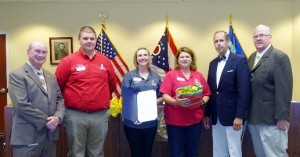 Leadership! It is a basic fundamental need for any organization to perform at its best. And whether you want to learn more about public service or have thought about becoming more involved in your community, participating in a formal leadership development program may be helpful.
Leadership! It is a basic fundamental need for any organization to perform at its best. And whether you want to learn more about public service or have thought about becoming more involved in your community, participating in a formal leadership development program may be helpful.
OSU Extension has been involved in such programs for over half a century and recent research shows such programs make a difference. Currently, OSU Extension Clermont County is working to address the needs of local elected officials and appointees of local government committees, zoning and planning commissions, school boards or task forces. The Clermont County Organizational Leadership Academy (CCOLA) includes eight, weekly two-hour workshops involving foundational principles of organizational leadership and decision-making tools enabling participants to learn more about their leadership style and those of others. It also provides opportunities to explore effective strategies for team-building, conducting effective meetings, communicating with citizens and media, managing conflict and building sustainable communities.
The components of the CCOLA can also be customized to fit a specific organization for hands-on training. The workshops below are available on single-session basis in addition to the multi-session Academy format. The sessions are:
- Public Officials and Public Service: Build a framework for improving your tenure and service in public office. Topics include Duties and Responsibilities of Public Officials, Codes of Ethics, Standards of Conduct, Conflict of Interest, and Open Meetings Laws/Executive Sessions.
- Team Building: Explore the principles for building effective working relationships with others, with organizations or local governments. Learn more about these relationships with Real Colors ®.
- Conducting Effective Meetings and Decision Making: The goal for every public official is to “make good decisions.” What is a good decision? How do we make them? Learn the most effective techniques to conducting effective meetings as well as decision-making processes.
- Communicating and Working with Citizens and the Media: How can you develop positive and effective working relationships with all community residents, as well as with media representatives? Polish your skills for building effective relationships, while engaging community residents and improving media relations.
- Building Sustainable Communities: Explore the relationships between growth, development, environment, ecology, social structures and the civic culture. Learn how to build sustainable communities in the areas you serve.
- Conflict Management and Dispute Resolution: Learn how to work through difficult situations by developing conflict and dispute resolution skills needed to create strong, lasting collaborations.
- Leadership Skills and Styles: Do you know your leadership style? Do you know that understanding leadership styles and types can help improve interpersonal relationships and the effectiveness of your organization(s)? Gain skills to improve the operations and effectiveness of your governing body and your personal decision-making.
- Intergovernmental Relations: Opportunities and Challenges for Cooperation: Explore Ohio law pertaining to opportunities and limitations for intergovernmental agreements and cooperative arrangements. Invest in opportunities to cooperate with others.
For more information about the Clermont County Organizational Leadership Academy or how to register, go to OSU Extension – Clermont County, go.osu.edu/ccola, or contact me using the information below. How are you making your organization or your community better?
For further information, contact Trevor Corboy, Clermont County Community Development Program Coordinator, at 513-732-7070 or email at corboy.3@osu.edu.

 dership development program has enabled participants to come together to collaborative in addressing a significant community challenge.
dership development program has enabled participants to come together to collaborative in addressing a significant community challenge. After a very engaging and successful Ohio Local Foods week in August, there was a variety of interest expressed in pursuing a center for small business owners to collaborate within Clermont County. As envisioned, this center would incorporate an incubator kitchen for cottage foods producers and other locally sourced value-added products to supply a wide variety of market sectors within the agriculture industry of Clermont County. A preliminary working group has been established to facilitate the process. Over the coming weeks the group will research facilities and design after which a larger group of producers and supporters will be convened to expand upon the foundation work and decide on the next steps in this venture.
After a very engaging and successful Ohio Local Foods week in August, there was a variety of interest expressed in pursuing a center for small business owners to collaborate within Clermont County. As envisioned, this center would incorporate an incubator kitchen for cottage foods producers and other locally sourced value-added products to supply a wide variety of market sectors within the agriculture industry of Clermont County. A preliminary working group has been established to facilitate the process. Over the coming weeks the group will research facilities and design after which a larger group of producers and supporters will be convened to expand upon the foundation work and decide on the next steps in this venture. Leadership! It is a basic fundamental need for any organization to perform as a well-balanced machine. We have learned from an earlier developed plan of work that addressing the needs of county elected officials is a necessity. Many of the public officials I met with during the first few months in my position confirmed this need. They have asked for education in leadership development, conducting effective meetings, communicating more effectively, and other key areas. Based upon these conversations, the
Leadership! It is a basic fundamental need for any organization to perform as a well-balanced machine. We have learned from an earlier developed plan of work that addressing the needs of county elected officials is a necessity. Many of the public officials I met with during the first few months in my position confirmed this need. They have asked for education in leadership development, conducting effective meetings, communicating more effectively, and other key areas. Based upon these conversations, the  Through early discussions with townships and villages, many officials and community members have expressed an interest in strategic planning and goal setting for their communities. This has added to the growing excitement of expansion and redevelopment of infrastructure throughout Clermont County, and community-based projects of this nature are currently being planned.
Through early discussions with townships and villages, many officials and community members have expressed an interest in strategic planning and goal setting for their communities. This has added to the growing excitement of expansion and redevelopment of infrastructure throughout Clermont County, and community-based projects of this nature are currently being planned. Many small towns want to improve their current condition for a number of reasons. What we often hear from residents and leaders is: “We are tired of our “best and brightest” leaving the area for college and never returning because we have no jobs/careers for them,” or “Our retired residents have to seek appropriate housing in other communities because there isn’t any here,” or “The youth that remain are not “work ready” and opioid use among them has become a real problem.” Some of these towns have existing community or economic development plans that, while they might offer viable solutions, were never fully implemented (the old “the plan sits on the shelf” complaint).
Many small towns want to improve their current condition for a number of reasons. What we often hear from residents and leaders is: “We are tired of our “best and brightest” leaving the area for college and never returning because we have no jobs/careers for them,” or “Our retired residents have to seek appropriate housing in other communities because there isn’t any here,” or “The youth that remain are not “work ready” and opioid use among them has become a real problem.” Some of these towns have existing community or economic development plans that, while they might offer viable solutions, were never fully implemented (the old “the plan sits on the shelf” complaint).
 Are leaders born or are they made? While the philosophers debate that question, consider this: For over a decade, Extension and the Ohio Sea Grant College Program have partnered with the Toledo Regional Chamber of Commerce to provide training focused on leadership skill development to more than 300 aspiring, new and experienced public officials.
Are leaders born or are they made? While the philosophers debate that question, consider this: For over a decade, Extension and the Ohio Sea Grant College Program have partnered with the Toledo Regional Chamber of Commerce to provide training focused on leadership skill development to more than 300 aspiring, new and experienced public officials. Obviously some of our social inventions for working together, resolving conflict, sharing resources and living together have not worked so well. We still settle some of our differences through violence, and there is still racism, prejudice and greed. There are far too many people who live in poverty, lack adequate food, water, education and medical care. However, looking at the facts we can see a decline in all these categories. In the area of hunger we now produce enough food to feed everyone in the world but not everyone has enough food, so we need to invent a new worldwide food distribution system. What we forget is that we invented the current worldwide food system and that
Obviously some of our social inventions for working together, resolving conflict, sharing resources and living together have not worked so well. We still settle some of our differences through violence, and there is still racism, prejudice and greed. There are far too many people who live in poverty, lack adequate food, water, education and medical care. However, looking at the facts we can see a decline in all these categories. In the area of hunger we now produce enough food to feed everyone in the world but not everyone has enough food, so we need to invent a new worldwide food distribution system. What we forget is that we invented the current worldwide food system and that 

 In the 23rd Edition of the Survey of Young Americans’ Attitudes Toward Politics and Public Service done by Harvard University, only 30% of those surveyed said they trusted local government to do the right thing all or most of the time. In a society that is increasingly distrustful of government and institutions, now more than ever our leaders need to make positive change through civic engagement. But
In the 23rd Edition of the Survey of Young Americans’ Attitudes Toward Politics and Public Service done by Harvard University, only 30% of those surveyed said they trusted local government to do the right thing all or most of the time. In a society that is increasingly distrustful of government and institutions, now more than ever our leaders need to make positive change through civic engagement. But 